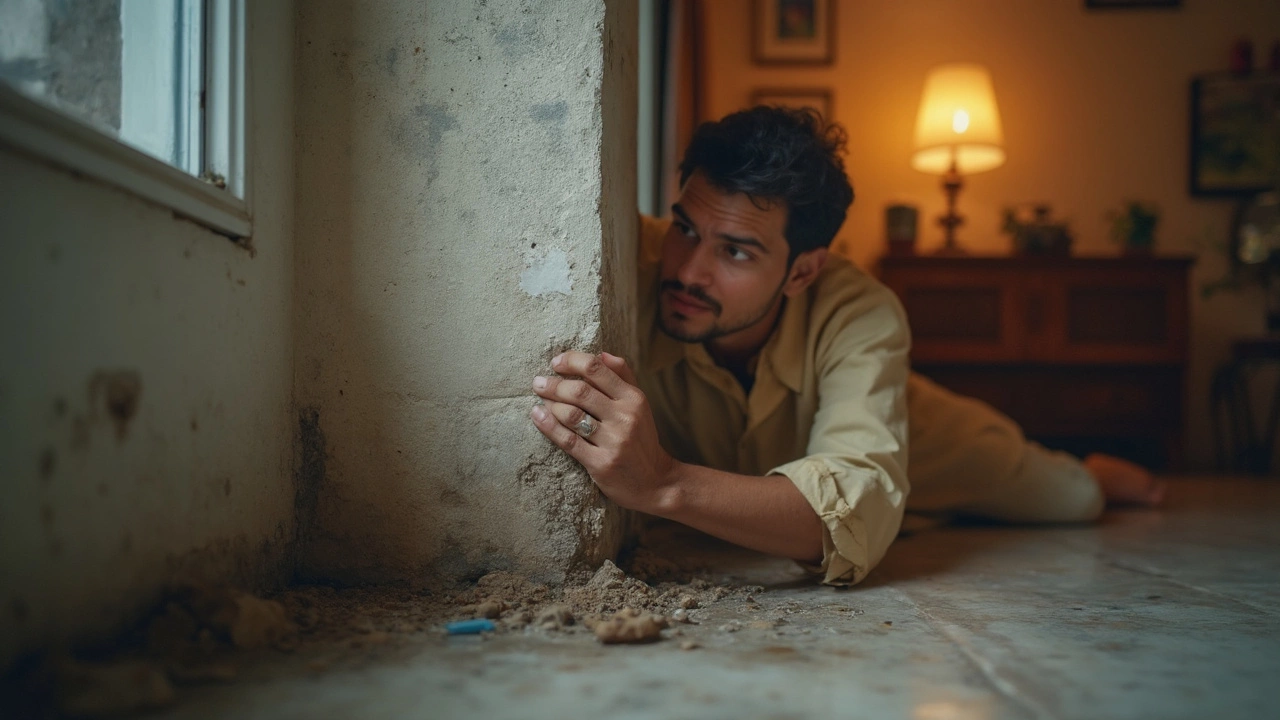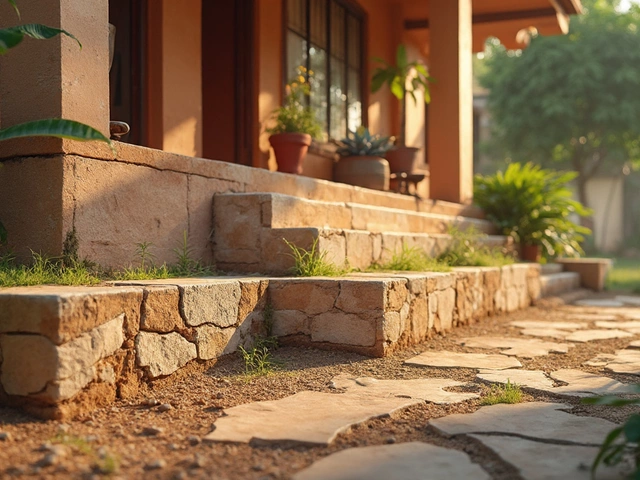Ever walked around your house and spotted a crack along the foundation, or maybe a mysterious wet spot that won’t dry out? Water damage can show up in ways you probably wouldn’t expect—sometimes, it looks as simple as peeling paint or a chalky white stain on the wall. If you know what to look for, you can save yourself a lot of trouble (and money) down the road.
The number one thing homeowners miss? Small hairline cracks or faint brown stains in the basement. Water doesn’t always leave big, obvious marks. Sometimes, it sneaks in slowly, creating a musty smell or that sticky, damp feeling in the air. Got pooling water near the base of your home after a rainstorm? That’s another red flag.
Don’t ignore doors and windows that suddenly become hard to open. You might think it’s just the humidity, but it could be your foundation shifting because of water damage. Even floors that feel a little uneven or walls that start to bow can give away problems long before you spot a flood or serious leak.
- Common Signs of Water Damage on Foundations
- What Causes Water Damage to Foundations?
- How to Inspect Your Foundation
- When to Get Professional Help
Common Signs of Water Damage on Foundations
Spotting water damage early can make all the difference for your home’s foundation repair costs. The tricky part is, water doesn’t always leave a huge puddle or dramatic mess behind. Sometimes, the clues are way more subtle.
Here’s what you should keep an eye out for:
- Cracks in foundation walls or floors: Not all cracks mean disaster, but wide, jagged, or growing cracks are a classic sign of water sneaking in and messing with your foundation. If you see horizontal cracks, those can be even worse than vertical.
- Efflorescence (white, chalky residue): When water moves through concrete, it drags minerals along. As the water evaporates, the minerals get left behind, looking like salt stains or powder. That’s a dead giveaway of past moisture problems.
- Damp spots and moldy smells: Don’t ignore musty odors or random wet patches, especially after it rains. If your basement smells like a wet towel, there’s probably a reason.
- Bowing or bulging walls: Too much water pressure from outside can push in the walls, making them curve inward. That’s one of the scarier forms of foundation damage.
- Sticking doors or windows: If things that used to open easily now stick, it could be your house subtly shifting.
- Rust on metal fixtures: Look at nails, pipes, or brackets in your basement or crawl space. Rust is a sign that extra moisture is hanging around where it shouldn’t be.
To put things in perspective, take a look at this quick breakdown:
| Sign | What It Means | Why It Matters |
|---|---|---|
| Cracks (over 1/4 inch) | Possible sinking or water erosion | Could lead to structural problems |
| Efflorescence | Past or ongoing water leaks | Makes other damage more likely |
| Musty smell | Hidden mold or dampness | Health risk, points to excess moisture |
| Bowed walls | Soil pressure from oversaturated ground | High risk of wall failure |
If you spot two or more of these warning signs, it’s time to check things out more closely or call a pro. A stitch in time here really can save your wallet—and your peace of mind.
What Causes Water Damage to Foundations?
So, what’s behind most water damage to a foundation? It mainly boils down to how water moves around and under your home. If you’re seeing signs like cracks or musty smells, it’s often tied to specific sources and habits.
Here are the most common culprits you should keep an eye on:
- Poor Drainage: If your gutters and downspouts are clogged or missing, water dumps right next to your home. Over time, all that water seeps down and messes with your foundation.
- Grading Issues: The ground around your home needs to slope away, not toward it. A flat or negative slope means rainwater pools by your foundation instead of running off.
- Plumbing Leaks: A busted pipe or faulty sump pump can keep the soil around your house constantly wet. Even a minor leak can do real damage over a few months.
- Heavy Rain or Flooding: Sometimes Mother Nature just dumps buckets of water. If your area gets a lot of rain or has a high water table, your foundation is at a bigger risk for moisture problems.
- Sprinkler Systems: If sprinklers hit the foundation day after day, or you overwater landscaping, that extra moisture can eventually work its way into the concrete.
Fun fact: According to the American Society of Civil Engineers, over 60% of U.S. homes built on clay-rich soils face foundation repair issues due to soil swelling and shrinkage after soaking in water. The constant movement stresses foundation walls until cracks appear.
| Cause | How It Damages Foundations |
|---|---|
| Poor drainage | Water soaks in, causing cracks and shifting soil |
| Negative grading | Water pools, raising moisture levels by the base |
| Plumbing leaks | Persistent moisture weakens the structure |
| Heavy rain/flooding | Overwhelms soil and foundation capacity |
| Sprinklers & overwatering | Promotes seepage into concrete |
When you spot early warning signs, it’s worth checking not just inside your house, but outside too—gutters, landscaping, and pipes all play a part. Tackling these root causes keeps small foundation problems from becoming giant headaches.

How to Inspect Your Foundation
Inspecting your foundation for water damage isn’t rocket science, but you do need to know where to look and what counts as a real problem. Here’s how to do a quick and effective check, even if you’ve never tried it before.
- Walk the outside of your home. Look for cracks in the concrete, spots where the soil is pulling away, or areas with poor drainage. Muddy spots or pools of water against the foundation are a giveaway something’s off.
- Check inside, especially the basement or crawl space. Use a flashlight to hunt for hairline cracks, damp spots, mold, or strange white powder on the walls (that’s efflorescence, left behind by water seeping through concrete).
- Smell the air. A musty smell is a big hint water is hanging around where it shouldn’t be. Trust your nose!
- Test doors and windows. If they start sticking more than usual, it could be because your foundation is moving. Don’t just chalk it up to humidity—double-check.
- Check for uneven floors or new gaps around trim and baseboards. Water damage can cause foundations to settle or shift, making floors slope and gaps appear out of nowhere.
Found a spot you’re not sure about? Stick a piece of masking tape along the edge of a crack and put the date on it. If it gets bigger over the next few weeks, don’t ignore it. Minor cracks (less than 1/8 inch wide) are pretty common, but if you see something bigger or wider than a pencil, get it checked out.
Here’s a quick look at what you might spot during an inspection:
| Sign | What It Means |
|---|---|
| Hairline cracks | Minor movement, often not serious if not growing |
| Damp spots or mold | Water has found a way in |
| Efflorescence (white powder) | Long-term moisture seepage |
| Bow in foundation wall | Serious pressure from water on the other side |
| Pooled water near wall | Poor drainage outside |
According to the American Society of Home Inspectors, "More than 60% of homes in the U.S. have some sort of below-ground moisture problem."
If you see signs of foundation movement or recurring moisture, get a pro to look at it before a little fix turns into a huge headache.
Remember, early action will save you the most money and hassle. It’s way easier to fix a small crack than a major structural problem.
When to Get Professional Help
Let’s be real—some water damage is too big for a quick fix or DIY patch. If you see foundation cracks wider than a quarter inch or notice water seeping inside after it rains, it’s time to call a foundation repair specialist. Ignoring these signs can turn a small problem into a massive (and pricey) repair job.
Keep an eye out for these signs that you need an expert’s help:
- You see horizontal or stair-step cracks along basement walls. These usually mean serious movement due to moisture issues.
- Pooled water doesn’t drain away from your home. Persistent dampness around the foundation can erode concrete fast.
- Your doors or windows won’t close right, or gaps are showing up around the frames. Foundation shifts from water damage can throw your whole house out of whack.
- You spot mold or a strong musty odor coming from the basement, which points to ongoing water leaks.
- The floor feels sloped, or you notice walls starting to bow or bulge. That’s never normal.
Did you know that nearly 60% of American homes have at least one foundation issue, and water is the leading cause? According to the Concrete Foundations Association, homes with poor drainage or improper grading are the most at risk.
| Problem | DIY Okay? | Call a Pro? |
|---|---|---|
| Hairline crack, stays dry | Yes | No |
| Crack wider than 1/4 inch | No | Yes |
| Standing water next to foundation | No | Yes |
| Mold/mildew indoors | No | Yes |
| Sticky doors/windows | No | Yes |
If you’re not sure whether the problem is serious, most foundation pros offer inspections for free or a low fee. Getting a professional opinion early can save you thousands by catching issues before they spiral. Don’t wait until you see a flood or major crack—use these warning signs as your cue to bring in the pros and protect your home for the long run.






